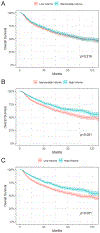The influence of facility volume on patient treatments and survival outcomes in nasopharyngeal carcinoma
- PMID: 33998094
- PMCID: PMC8349783
- DOI: 10.1002/hed.26739
The influence of facility volume on patient treatments and survival outcomes in nasopharyngeal carcinoma
Abstract
Background: This study evaluates the influence of facility case-volume on nasopharyngeal carcinoma (NPC) treatments and overall survival (OS).
Methods: The 2004-2015 National Cancer Database was queried for patients with NPC receiving definitive treatment.
Results: A total of 8260 patients (5-year OS: 63.4%) were included. The 1114 unique facilities were categorized into 854 low-volume (treating 1-8 patients), 200 intermediate-volume (treating 9-23 patients), and 60 high-volume (treating 24-187 patients) facilities. Kaplan-Meier log-rank analysis demonstrated significantly improved OS with high-volume facilities (p < 0.001). On cox proportional-hazard multivariate regression after adjusting for age, sex, income, insurance, comorbidity index, histology, AJCC clinical stage, and treatment type, high-volume facilities were associated with lower mortality risk than low-volume (HR = 0.865, p = 0.019) and intermediate-volume facilities (HR = 0.916, p = 0.004). Propensity score matching analysis confirmed this association (p < 0.001).
Conclusion: Higher facility volume was an independent predictor of improved OS in NPC, suggesting a possible survival benefit of referrals to high-volume medical centers.
Keywords: facility volume; hospital volume; nasopharyngeal carcinoma; outcomes; overall survival.
© 2021 Wiley Periodicals LLC.
Conflict of interest statement
Figures



Similar articles
-
A Comprehensive Analysis of Treatment Management and Survival Outcomes in Nasopharyngeal Carcinoma.Otolaryngol Head Neck Surg. 2021 Jul;165(1):93-103. doi: 10.1177/0194599820973241. Epub 2020 Nov 24. Otolaryngol Head Neck Surg. 2021. PMID: 33231508
-
Facility Volume and Survival in Nasopharyngeal Carcinoma.Int J Radiat Oncol Biol Phys. 2018 Feb 1;100(2):408-417. doi: 10.1016/j.ijrobp.2017.09.038. Epub 2017 Sep 28. Int J Radiat Oncol Biol Phys. 2018. PMID: 29100787
-
Prognostic Value of the Albumin-to-Alkaline Phosphatase Ratio before Chemoradiotherapy in Patients with Nonmetastatic Nasopharyngeal Carcinoma.Chemotherapy. 2021;66(1-2):40-46. doi: 10.1159/000513058. Epub 2021 Feb 18. Chemotherapy. 2021. PMID: 33601377
-
The Influence of Facility Volume and Type on Skull Base Chordoma Treatment and Outcomes.World Neurosurg. 2022 Oct;166:e561-e567. doi: 10.1016/j.wneu.2022.07.064. Epub 2022 Jul 19. World Neurosurg. 2022. PMID: 35868508
-
Facility Volume as a Prognosticator of Survival in Locally Advanced Papillary Thyroid Cancer.Laryngoscope. 2023 Feb;133(2):443-450. doi: 10.1002/lary.30280. Epub 2022 Jul 13. Laryngoscope. 2023. PMID: 35822421 Free PMC article.
Cited by
-
Odds of Stage IV Bone Cancer Diagnosis Based on Socioeconomic and Geographical Factors: A National Cancer Database (NCDB) Review.Cureus. 2023 Feb 9;15(2):e34819. doi: 10.7759/cureus.34819. eCollection 2023 Feb. Cureus. 2023. PMID: 36919067 Free PMC article.
-
Nasopharyngeal carcinoma. A "different" head and neck tumour. Part B: treatment, prognostic factors, and outcomes.Acta Otorhinolaryngol Ital. 2023 Jun;43(3):155-169. doi: 10.14639/0392-100X-N2223. Acta Otorhinolaryngol Ital. 2023. PMID: 37204840 Free PMC article. Review.
-
The impact of facility type and volume on treatment and overall survival in craniopharyngioma.Pituitary. 2023 Dec;26(6):686-695. doi: 10.1007/s11102-023-01359-8. Epub 2023 Oct 17. Pituitary. 2023. PMID: 37847431
-
Precision Medicine for Nasopharyngeal Cancer-A Review of Current Prognostic Strategies.Cancers (Basel). 2024 Feb 24;16(5):918. doi: 10.3390/cancers16050918. Cancers (Basel). 2024. PMID: 38473280 Free PMC article. Review.
References
-
- Torre LA, Bray F, Siegel RL, Ferlay J, Lortet-Tieulent J, Jemal A. Global cancer statistics, 2012. CA Cancer J Clin. 2015;65(2):87–108. - PubMed
-
- PDQ. PDQ® - NCI's Comprehensive Database. National Cancer Institute; https://wwwcancergov/publications/pdq Accessed Dec 20, 2020.
-
- NCCN. National Comprehensive Cancer Network. https://www.nccn.org/. Accessed Dec 20, 2020.
-
- Colevas AD, Yom SS, Pfister DG, et al. NCCN guidelines insights: head and neck cancers, version 1.2018. J Natl Compr Canc Netw. 2018;16(5):479–90. - PubMed
-
- Wei WI, Sham JS. Nasopharyngeal carcinoma. Lancet. 2005;365(9476):2041–54. - PubMed
Publication types
MeSH terms
Grants and funding
LinkOut - more resources
Full Text Sources
Other Literature Sources
Medical

